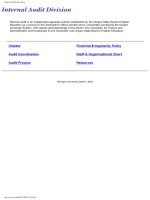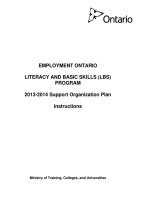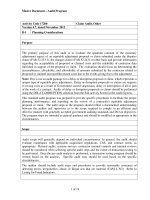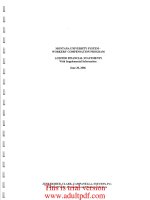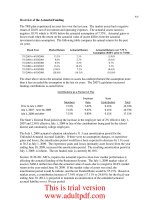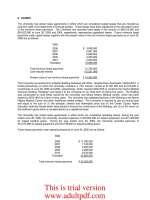MONTANA UNIVERSITY SYSTEM WORKERS'''' COMPENSATION PROGRAM NOTES T O FINANCIAL STATEMENTS (Continued)_part2 pot
Bạn đang xem bản rút gọn của tài liệu. Xem và tải ngay bản đầy đủ của tài liệu tại đây (1.92 MB, 11 trang )
MONTANA UNIVERSITY SYSTEM
-
WORKERS' COMPENSATION PROGRAM
NOTES TO FINANCIAL STATEMENTS (Continued)
June
30,2006
2.
CASH
AND
INVESTMENTS (Continued)
Concentration of Credit Risk
Concentration of credit risk is the risk of loss attributed to the magnitude of a government's investment in a
single issuer. GASB 40 requires that a government entity disclose the amount invested in a separate issuer
(except investments held in the U.S. government or investments guaranteed by the U.S. government) when
that amount is at least 5% of total investments. As of June 30, 2006, the Program had the following
investments that made up more than 5% of the total investments of $1,954,260:
Percentage of
Fair Value ~nvestments
Nebo School District, Utah County, Utah, General Obligation
-
-
-
Refunding Bonds, ~eri~s 1998B 100,OO 1 5.12%
Clark County, Nevada, General Obligation Flood Control Bonds, Series
1998 100,242 5.13%
Metropolitan Park District of Tacoma, Pierce County, Washington,
Limited Tax General Obligation Bonds, Series
2002A 199,022 10.18%
Wyoming Community Development Authority, Housing Revenue
Bonds, Series 1 and 2,2004 98,972 5.06%
Wyoming Community Development Authority, Housing Revenue
Bonds, Series 1 and 2,2004 145,432 7.44%
Douglas County, Nevada, General Obligation Refunding Bonds, Series
2003 246,227 12.60%
Public Hospital District No. 1 of King County, Washington, Hospital
Facilities Revenue and Refunding Bonds, Series 1998 100,858 5.16%
Snohomish County, Washington, General Obligation Bonds 249,003 12.74%
Paris,Texas Water and Sewer Revenue and Refunding Bonds 100,293 5.13%
Salt Lake City, Utah, Water and Sewer Revenue and Refunding Bonds
104,83 1 5.36%
Mequon
&
Thiensville, Wisconsin, School District School Improvement 101,439 5.19%
Bonds
Illinois Municipal Electric Agency Power Supply Refunding Bonds 101,683 5.20%
Montana Facilities Financial Authority Health Care Facilities Revenue
and Refunding Developmental Center Project Bonds 127,452 6.52%
Texas State Public Finance Authority, Texas Building and Procurement
Revenue Bonds 178,805 9.15%
This is trial version
www.adultpdf.com
MONTANA UNIVERSITY SYSTEM
-
WORKERS' COMPENSATION PROGRAM
NOTES TO FINANCIAL STATEMENTS (Continued)
June
30,2006
2.
CASH
AND
INVESTMENTS (Continued)
Custodial Credit Risk
Custodial credit risk for investments is the risk that, in the event of the failure of the counterparty to a
transaction, a government will not be able to recover the value of the investment or collateral securities
that are in the possession of the outside party. Cash and money market funds are insured.
The Program's short-term and long-term investments are held by a bank-administered trust fund. These
investments are uninsured, unregistered, and held by the trustee in the Program's name, therefore classified
as category
2
investments.
Information regarding the collateralization and risk of funds held by the University of Montana is available
in the University's comprehensive annual financial report. There is no regulatory oversight for the
University's investment pool, and the pool does not have a credit quality rating. Participants' equity in the
pool approximates the fair value of the underlying investments.
Interest Rate Risk
Interest rate risk is the risk that changes in interest rates will adversely affect the fair value of an
investment. The Program investment policies do not
formally address interest rate risk.
In accordance
with
GASB
Statement No. 40, the Program has selected the effective duration method to disclose interest
rate risk.
GASB Statement No. 40 defines duration as a measure of the debt investment's exposure to fair value
changes arising from changing interest rates. It uses the present value of cash flows, weighted for those
cash flows as a percentage of the investment's full price. Effective duration makes assumptions regarding
the most likely timing and amounts of variable cash flows arising from such investments as callable bonds,
prepayments, and variable-rate debt.
The Program's investments are categorized below to disclose credit and interest rate risk as of June 30,
2006. Credit risk reflects the bond quality rating, by investment type, as of June 30, 2006.
If a bond
investment type is unrated, the quality type is indicated by a NR (not rated). Interest rate risk is disclosed
using effective duration. Both the credit ratings and duration have been calculated excluding cash
equivalents.
Credit
Fair Quality Effective
Security Investment Type Value Rating Duration
Municipal bonds
$
127,452
A+
1.81
Municipal bonds 593,649
AA
.3
Municipal bonds 101,439
AA
1 .65
Municipal bonds 1.131.720
AAA
.32
This is trial version
www.adultpdf.com
MONTANA UNIVERSITY SYSTEM
-
WORKERS' COMPENSATION PROGRAM
NOTES
TO
FINANCIAL STATEMENTS (Continued)
June 30,2006
2.
CASH AND
INVESTMENTS (Continued)
The following is a calculation of the increase (decrease) in the fair value of investments for the fiscal year
ended June 30, 2006:
Fair value at June 30,2006
Add: Proceeds of investments sold in fiscal year 2006
Less: Cost of investments purchased in fiscal year 2006
Less: Fair value at June 30,2005
Change in fair value of investments
$
(u
3.
LONG-TERM DEBT
On July 11, 2003, the Program issued $2,050,000 of Series 2003 Workers' Compensation Program
Revenue Bonds. The bonds were issued at par, bear interest of
2.8%, and are secured by premiums
charged to participants within the Montana University System. Proceeds from the bonds were used to
establish an initial reserve for self-insured claims.
Long-term debt as of June 30,2006, consists of
$2,050,000 Series 2003 Workers' Compensation Program Revenue
Bonds, 2.8% interest due semiannually, principal annually to May
2008; secured by premium revenue
Less current portion (420,000)
During the period ended June 30,2006, $33,813 of interest expense was recognized.
Debt service requirements to maturity on the revenue bonds at June 30,2006, are as follows:
Year endinp June 30, Principal Interest Total
2007 420,000 23,800 443,800
2008 430.000 12.040 442.040
4.
RELATED PARTIES
Certain employees of the campuses of the university system provide services to the Program at no charge.
The value of such services has not been determined.
This is trial version
www.adultpdf.com
MONTANA UNIVERSITY SYSTEM
-
WORKERS' COMPENSATION PROGRAM
NOTES TO FINANCIAL STATEMENTS (Continued)
June
30,2006
5.
UNPAID CLAIMS LIABILITIES
As discussed in footnote 1, the Program establishes actuarial estimated unpaid claims liabilities. The
estimated unpaid claims incurred but not reported and loss development liability have been adjusted to
reflect the actuarial estimates of the ultimate cost of claims. The management of the Program has set the
unpaid claims liability at the actuary's best estimate for 2006. The following represents changes in the
aggregate unpaid claims liabilities, excluding unallocated claim adjustment expense, for the Authority for
2006:
Total present value of estimated unpaid
claim losses at beginning of year
Changes in the estimated unpaid claim losses:
Provision for insured events of the current year
Increase (decrease) in provision for insured
events of prior years
Total incurred claims 2.5 15,000
Payments (including claims legal defense):
Claims paid attributable to insured events of current year
Claims paid attributable to insured events of prior years
Total payments
1.1
14.567
Total present value of estimated unpaid
claim losses at end of year
The estimated liability for workers' compensation claims as of June 30,2006 consist of the following:
Estimated claims reported but unpaid
Estimated claims incurred but not reported and loss development
This is trial version
www.adultpdf.com
MONTANA UNIVERSITY SYSTEM
-
WORKERS' COMPENSATION PROGRAM
CLAIMS DEVELOPMENT INFORMATION
F
Fiscal and Policy Year Ended
2004 2005
r
1. Required contribution and investment revenue
L
d
Earned
$
2,425,230 $3,047,625
Ceded
Net earned
Ld
2. Unallocated expenses
r
bd
3. Estimated incurred claims and expenses, end of policy year
Incurred 2,174,000 2,366,000
Ceded
Net incurred
r
4. Net paid (cumulative) as of:
11
End of policy year
One year later
r
Two years later
b
d
5. Reestimated ceded claims and expenses
-
-
r
6. Reestimated net incurred claims and expenses
b
4
End of policy year 2,174,000 2,366,000
Ic
One year later
2,174,000 2,565,000
Two years later 2,037,000
L
d
7.
Increase (decrease) in estimated net incurred claims and
r
expenses from end of policy year (1 37,000) 199,000
k4
See the accompanying independent autitors' report on supplemental information
16
This is trial version
www.adultpdf.com
bd
?
i
l
F
unkermier
Clark
,
d
Campanella
Stevens
P.C.
Montana Club Building
P.O.
Box 1164
Helena, Montana 59624
ph.
(406) 442-6901
fx. (406) 442-9690
www.jccscpa.com
Certified Public Accountants and Business Advisors
REPORT ON INTERNAL CONTROL OVER FINANCIAL REPORTING
AND
ON COMPLIANCE
AND
OTHER MATTERS BASED ON AN AUDIT OF FINANCIAL STATEMENTS
PERFORMED IN ACCORDANCE WITH GOVERNMENT AUDITING STANDARDS
To the Committee
Montana University System
-
Workers' Compensation Program
Missoula, Montana
We have audited the financial statements of Montana University System
-
Workers' Compensation Program,
(an enterprise fund of the State of Montana) as of and for the year ended June 30, 2006, and have issued our
report thereon dated September
7,
2006. We conducted our audit in accordance with auditing standards
generally accepted in the United States of America and the standards applicable to financial audits contained in
Government Auditing Standards,
issued by the Comptroller General of the United States.
Internal Control Over Financial Reuorting
In planning and performing our audit, we considered Montana University System
-
Workers' Compensation
Program's internal control over financial reporting in order to determine our auditing procedures for the purpose
of expressing our opinion on the financial statements and not to provide assurance on the internal control over
financial reporting. Our consideration of the internal control over financial reporting would not necessarily
disclose all matters in the internal control over financial reporting that might be material weaknesses. A
material weakness is a reportable condition in which the design or operation of one or more of the internal
control components, does not reduce to a relatively low level the risk that misstatements in amounts that would
be material in relation to the financial statements being audited may occur and not be detected within a timely
period by employees in the normal course of performing their assigned functions. We noted no matters
involving the internal control over financial reporting and its operation that we consider to be material
weaknesses.
Compliance and Other Matters
As part of obtaining reasonable assurance about whether Montana University System
-
Workers' Compensation
Program's financial statements are free of material misstatement, we performed tests of its compliance with
certain provisions of laws, regulations, contracts, and grant agreements, noncompliance with which could have
a direct and material effect on the determination of financial statement amounts. However, providing an
opinion on compliance with those provisions was not an objective of our audit, and accordingly, we do not
express such an opinion. The results of our tests disclosed no instances of noncompliance that are required to
be reported under Government Auditing Standards.
However, we noted certain matters that we reported to management of Montana University System
-
Workers'
Compensation Program in a separate letter dated September 7,2006.
Bozeman Great Falls Helena Kalispell Missoula Whitefish
This is trial version
www.adultpdf.com
Independent Auditors' Report on Internal Control and Compliance
Page
2
This report is intended solely for the information and use of the audit committee, management, others within the
Montana University System
-
Workers' Compensation Program, and is not intended to be and should not be
used by anyone other than these specified parties.
Junkermier, Clark, Campanella, Stevens,
P.
C.
Helena, Montana
September
7,2006
This is trial version
www.adultpdf.com
'The
University
of
Vice President, Administration and Finance
Montana
The University of Montana
Missoula, Montana
59812-3826
Phone: (406) 243-4662
FAX:
(406)
243-5537
October
18,2006
Junkerrnier, Clark, Campanella, Stevens, P.C.
Certified Public Accountants
P.O. Box
1
164
Helena, Montana
59624
RE:
Montana University System -Workers Compensation Program response
Dear Junkermier, Clark, Campanella, Stevens, P.C.
We have reviewed the draft audit report for the Montana University System -Workers
Compensation Program. We are pleased that our Program meets accounting standards and that
no recommendations for improvement were noted.
Sincerelv.
Rosi Keller, Associate Vice President, UM
Chair, Finance Committee, Montana University System
-
Workers' Compensation Program
hd
An
Equal
Opportunity
University
This is trial version
www.adultpdf.com
Junkermier
Clark
Campanella
Stevens
EC.
Montana Club Building
P.O.
Box
1164
Helena, Montana
59624
ph.
(406) 442-6901
fx.
(406) 442-9690
www.jccscpa.com
Certified Public Accountants and Business Advisors
September 7,2006
To the Committee
Montana University System
-
Workers' Compensation Program
Missoula, Montana
59801
We have audited the financial statements of Montana University System
-
Workers' Compensation
Program, for the year ended June 30, 2006 and have issued our report thereon September
7,
2006.
Professional standards require that we provide you with the following information related to our audit.
Our Responsibilitv under Generally Accepted Auditinp Standards and
Government
Auditing
Standards
As stated in our engagement letter July 21, 2005 and our renewal letter dated July 10, 2006, our
responsibility, as described by professional standards, is to plan and perform our audit to obtain
reasonable, but not absolute, assurance about whether the financial statements are free of material
misstatement and are fairly presented in accordance with U.S. generally accepted accounting principles.
Because an audit is designed to provide reasonable, but not absolute assurance and because we did not
perform a detailed examination of all transactions, there is a risk that material misstatements may exist
and not be detected by us.
As part of our audit, we considered the internal control of Montana University System
-
Workers'
Compensation Program. Such considerations were solely for the purpose of determining our audit
procedures and not to provide any assurance concerning such internal control.
As part of obtaining reasonable assurance about whether the financial statements are free of material
misstatement, we performed tests of Montana University System
-
Workers' Compensation Program's
compliance with certain provisions of laws, regulations, contracts, and grants. However, the objective
of
our tests was not to provide an opinion on compliance with such provisions.
Si~nificant
account in^
Policies
Management has the responsibility for selection and use of appropriate accounting policies.
In
accordance with the terms of our engagement letter, we will advise management about the
appropriateness of accounting policies and their application. The significant accounting policies used by
Montana University System
-
Workers' Compensation Program, are described in Note
1
to the financial
statements. No new accounting policies were adopted and the application of existing policies was not
changed during the fiscal year ended June 30, 2006. We noted no transactions entered into by the
Program during the year that were both significant and unusual, and of which, under professional
standards, we are required to inform you, or transactions for which there is a lack of authoritative
guidance or consensus.
Bozeman Great Falls Helena Kalispell Missoula
Whitefish
This is trial version
www.adultpdf.com
To the Committee
Montana University System
-
Workers' Compensation Program
September 7,2006
Page 2
Accountinp Estimates
Accounting estimates are an integral part of the financial statements prepared by management and are
based on management's knowledge and experience about past and current events and assumptions about
future events. Certain accounting estimates are particularly sensitive because of their significance to the
financial statements and because of the possibility that future events affecting them may differ
significantly from those expected. The most sensitive estimate affecting the financial statements was the
estimated claims liability.
Management's estimate of the claims estimate is based on an actuarial calculation performed by
Milliman, Inc., the Program's consulting actuaries. We evaluated the key factors and assumptions used to
develop the estimated claims liability in determining that it is reasonable in relation to the financial
statements taken as a whole.
Audit Adiustments
For purposes of this letter, professional standards define an audit adjustment as a proposed correction of
the financial statements that, in our judgment, may not have been detected except through our auditing
procedures. An audit adjustment may or may not indicate matters that could have a significant effect on
the Organization's financial reporting process (that is, cause future financial statements to be materially
misstated). In our judgment, none of the adjustments we proposed, whether recorded or unrecorded by
the Organization, either individually or in the aggregate, indicate matters that could have a significant
effect on the Organization's financial reporting process.
Disa~reements with Manapement
For purposes of this letter, professional standards define a disagreement with management as a matter,
whether or not resolved to our satisfaction, concerning a financial accounting, reporting, or auditing
matter that could be significant to the financial statements or the auditor's report. We are pleased to report
that no such disagreements arose during the course of our audit.
Consultations with Other Independent Accountants
In some cases, management may decide to consult with other accountants about auditing and accounting
matters, similar to obtaining a "second opinion" on certain situations. If a consultant involves application
of an accounting principle to the Organization's financial statements or a determination of the type of
auditor's opinion that may be expressed on those statements, our professional standards require the
consulting accountant to check with us to determine that the consultant has all the relevant facts. To our
knowledge, there were no such consultations with other accountants.
This is trial version
www.adultpdf.com
To the Committee
Montana University System
-
Workers' Compensation Program
September
7,2006
Page
3
Issues Discussed Prior to Retention of Independent Auditors
We generally discuss a variety of matters, including the application of accounting principles and auditing
standards, with management each year prior to retention as the Program's auditors. However, these
discussions occurred in the normal course of our professional relationship and our responses were not a
condition to our retention.
Difficulties Encountered in Performin9 the Audit
We encountered no significant difficulties in dealing with management in performing and completing our
audit.
This information is intended solely for the use of the Committee and management of Montana University
System
-
Workers' Compensation Program, and should not be used for any other purpose.
Junkermier, Clark, Campanella, Stevens, PC
Helena, Montana
This is trial version
www.adultpdf.com
